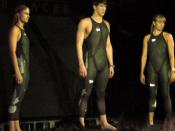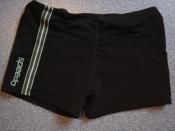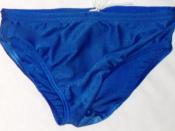How Fast Can You Go? What is an Olympic swimmer to do when he or she has tried everything from training to nutrition in order to achieve success? Perhaps change the swimsuit. Speedo is just one company that has invented an advanced body suit fabricated to improve swim times by up to three percent. This new revolutionary full length bodysuit known as Fastskin has set the pace for modern technology in swimwear.
The key to Fastskin is the style in which it mimics shark skin. The shark's body shape is not very hydrodynamic and should make it slow in the water. However, over millions of years nature has evolved a series of dermal denticles found on the skin of the shark. These tiny v-shaped ridges decrease drag and turbulence around their bodies, allowing surrounding water to pass over them more efficiently. Fastskin replicates the skin ridges by a unique body scanning process that creates the suit to exactly match the contours of the swimmer's body.
The suit is built to co-ordinate the swimmer's muscles, and the seams provide tendon-like tension. As a result, the water is sucked closer to the body and reduces friction drag, allowing the body to slip through the water more smoothly.
Though anyone can order this new body suit, Fastskin was designed primarily for competitive swimming. Exact measurements of elite swimmers are taken by a 3-D laser scanner. The result is a construction of a 3-D garment cut to the shape of an elite swimmer. The twenty six stitches per every three centimeters of seaming create complete freedom of movement yet minimizes the dragging. The inner arms of the bodysuit incorporate a gripper fabric that mimics skin, which increases friction and gives the swimmer a greater grip and feel in the water.
Initially for the Olympic trials all bodysuits, including Speedo's Fastskin, were banned for fear that some swimmers would not be able to obtain them in time for the trials. Yet the companies that created the new swim gear produced enough suits for all 1,306 participants. Therefore the suit preference was significantly seen during the freestyle and butterfly events. In the men's 400 freestyle and the women's 100 butterfly, all but 10 of 167 competitors wore some version of a nontraditional suit.
After researching the Fastskin body suit it is hard for me to not believe the positive effects it has produced. With all the testing and observation, many competitive swimmers are now turning to this new style to speed there time. Though I will never have any future plans about entering an Olympic swimming event, the idea that technology has created a swimsuit that mimics a shark's skin is very interesting. As a result of researching this unique bodysuit, if I ever decide to change my mind about entering the Olympics, the Fastskin suit has affected my decision in purchasing swim gear. However, for a University of Florida aerobic swimming class, I think I will stick to the traditional one piece suit.





